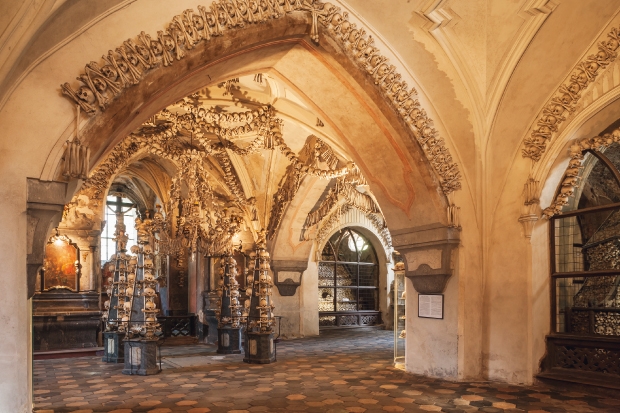Skulls, femurs, ribs, pelvises, piled on top of each other in a chaotic heap: this, Denise Inge discovered, was what she and her husband John were living on top of in their pretty house in Worcester Cathedral Close, into which they had recently moved when John became the diocesan bishop. The house is on top of a medieval charnel house that can be reached by opening a trap-door in the cellar. Inge opens her book with these words:
I live over dead men’s bones. Dead women’s, too, for all I know. Every day when I leave my house to escort my children to school, I walk over them.They insist on nothing, demand or require of me nothing except the admission, which I make seldom and reluctantly, that one day I shall join them in bare beauty, stripped even of flesh and sinews, disjointed, naked and alone.
It will happen to all of us, of course — as we seldom and reluctantly admit — but to Denise Inge it has already happened. She died of cancer on Easter Day this year, aged 53, soon after finishing this book, which is a travel book about ossuaries and a meditation on bones. A posthumous book is not necessarily a good book: we must avoid the funereal tones of whispered over-praise that are all too easily lavished on the works of the prematurely deceased. But Inge writes with freshness and grace about a subject many of us would rather not think about: the physical reality of earthly existence post-death.
She sets out with a friend across Europe to visit four charnel houses and ossuaries in obscure places, describing as she goes the casual discomforts and bewilderments of foreign travel. In Czermna in Poland, hundreds of fidgety schoolchildren are crammed into the ossuary with her, and they’re lectured to by a ‘femur-wielding nun’ with a microphone.
In Sedlec in the Czech Republic, the ossuary is decorated with creepy artworks made of human bones, ‘ropes of skulls hung as if they were festive garlands’. In Hallstatt in Austria, the skulls of the locals are painted with wreaths of laurel, ivy, oak or rose, and each has the name of the person it once was inscribed on its forehead in gothic script. ‘It is the queerest sight,’ Inge writes — ‘these skulls, universal emblem of death, overlaid with flowering fecundity. You can stare back at your very own mum, your lavender-scented auntie, the granddad who taught you to tie your shoelace.’ In Naters in Switzerland the ossuary’s wall of bones is 12 feet high and twice as wide, craniums stacked on femurs ‘so it looks as if each skull is spewing the knuckle end of a femur out of its mouth.’ Inge admits to a fleeting temptation to yank a few of the heads out of the bottom of the heap and bring the whole wall tumbling down, as with a topple-tower brick game. She is perpetually astounded by the vast numbers of bones: ‘the solidarity of the dead: the overall effect is unity’.
Although she tells us in the introduction that she wrote much of the book before the diagnosis, I scoured each sentence for the foresight of the soon-to-die, savouring the last gems of her wisdom, more than I would if reading a living author who might tap out 80,000 more words next year. She repaid this lavishly: she is a wise and thoughtful writer, utterly alive in her writing and observing, and a savourer of joy (as was the poet Thomas Traherne, of whom Inge was a renowned scholar).
I loved her description of holding a cappuccino cup to her lips in both hands as she looked out of a train window in Austria, and, doing this, feeling she was holding the whole of the landscape and the whole of life in both hands. She tells us that when you know you’re soon going to die, life does not become more precious, but more delicious.
I thought she might bombard us with Christian comforts, being a Christian person and a clergy wife, but she doesn’t, although we feel her Anglican calm and faith under the surface. The voice is her own: sceptical, funny, frank and shot through with a sparkling zest for life and love of family. The book is dedicated ‘To Eleanor and Olivia, daughters of my heart.’






Comments